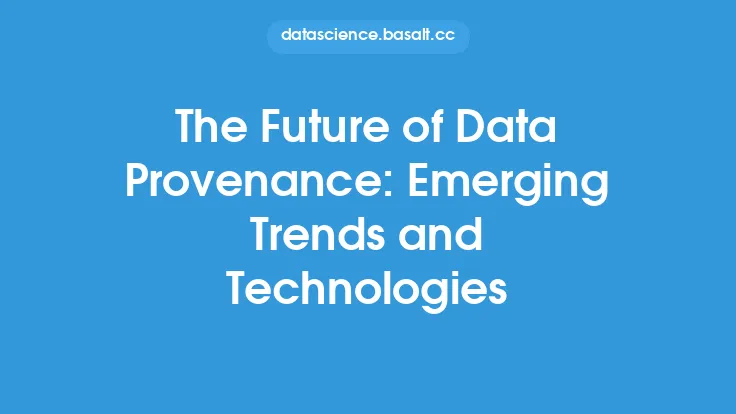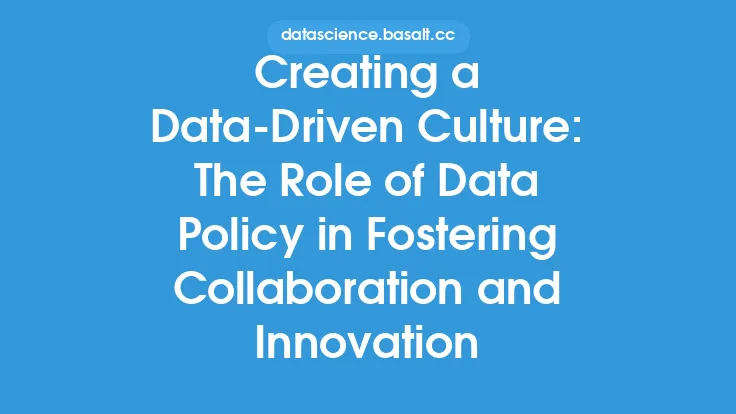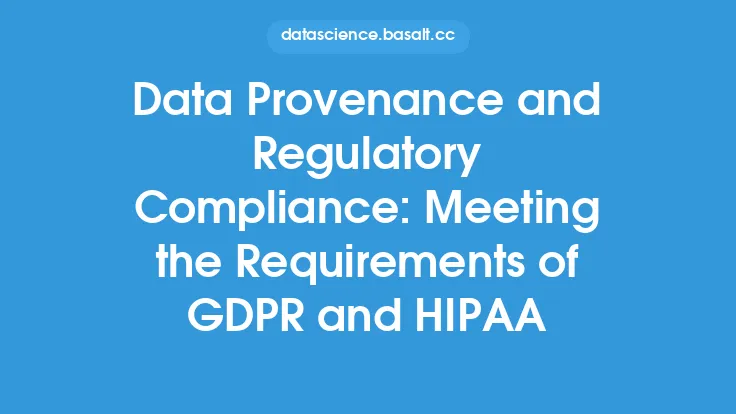Data provenance is a critical aspect of data quality that refers to the documentation of the origin, processing, and evolution of data over its entire lifecycle. It provides a detailed record of the data's history, including where it came from, how it was collected, processed, and transformed, and who was involved in these processes. This information is essential for ensuring the reliability, reproducibility, and trustworthiness of research findings, as well as for facilitating collaboration and data sharing among researchers and organizations.
Introduction to Data Provenance Concepts
Data provenance involves tracking and recording various types of metadata, including descriptive metadata, structural metadata, and administrative metadata. Descriptive metadata provides context about the data, such as its meaning, structure, and content. Structural metadata describes the relationships between different data elements, while administrative metadata includes information about data ownership, access controls, and preservation. By capturing and managing these different types of metadata, data provenance provides a comprehensive understanding of the data's origins, quality, and limitations.
Data Provenance Models and Standards
Several data provenance models and standards have been developed to facilitate the documentation and exchange of provenance information. The W3C Provenance Working Group, for example, has developed the PROV (Provenance) data model, which provides a standardized framework for representing and exchanging provenance information. Other models and standards, such as the Open Provenance Model (OPM) and the ISO 8000-120 standard, also provide guidelines and frameworks for capturing and managing provenance information. These models and standards help ensure that provenance information is consistent, accurate, and interoperable across different systems and applications.
Data Provenance Techniques and Tools
Various techniques and tools are used to capture and manage data provenance, including data logging, data tracking, and data annotation. Data logging involves recording information about data processing and transformation events, such as data ingest, data cleaning, and data aggregation. Data tracking involves monitoring data movement and access, while data annotation involves adding descriptive metadata to the data to provide context and meaning. Tools such as provenance-aware databases, workflow management systems, and data cataloging platforms provide support for these techniques and help automate the process of capturing and managing provenance information.
Data Provenance and Reproducible Research
Data provenance is essential for ensuring the reproducibility of research findings, as it provides a detailed record of the data's history and evolution. By tracking data provenance, researchers can identify potential sources of error or bias, verify the accuracy of results, and reproduce findings using the same data and methods. Data provenance also facilitates collaboration among researchers by providing a shared understanding of the data's origins, quality, and limitations. This enables researchers to build upon each other's work, compare results, and integrate findings from different studies.
Data Provenance and Collaboration
Data provenance plays a critical role in facilitating collaboration among researchers and organizations by providing a common framework for understanding and sharing data. By capturing and managing provenance information, collaborators can ensure that data is accurate, reliable, and consistent, which helps build trust and confidence in the research findings. Data provenance also enables collaborators to track data changes, identify potential issues, and resolve conflicts, which helps ensure the integrity and validity of the research.
Data Provenance and Data Quality
Data provenance is closely tied to data quality, as it provides a detailed record of the data's history and evolution. By tracking data provenance, data quality issues such as errors, inconsistencies, and biases can be identified and addressed. Data provenance also helps ensure that data is accurate, complete, and consistent, which is essential for making informed decisions and drawing reliable conclusions. Furthermore, data provenance provides a framework for evaluating data quality, which helps ensure that data meets the required standards and specifications.
Data Provenance and Metadata Management
Data provenance involves the management of various types of metadata, including descriptive, structural, and administrative metadata. Effective metadata management is critical for ensuring that provenance information is accurate, complete, and consistent. This involves developing and implementing metadata standards, using metadata management tools and platforms, and establishing metadata governance policies and procedures. By managing metadata effectively, organizations can ensure that provenance information is reliable, trustworthy, and accessible, which helps support data-driven decision-making and research.
Data Provenance and Data Sharing
Data provenance plays a critical role in facilitating data sharing among researchers and organizations by providing a common framework for understanding and sharing data. By capturing and managing provenance information, data providers can ensure that data is accurate, reliable, and consistent, which helps build trust and confidence in the data. Data provenance also enables data consumers to evaluate the quality and reliability of the data, which helps ensure that data is used appropriately and effectively. Furthermore, data provenance provides a framework for tracking data usage, which helps ensure that data is used in accordance with applicable laws, regulations, and policies.
Conclusion
Data provenance is a critical aspect of data quality that provides a detailed record of the data's history and evolution. It involves tracking and recording various types of metadata, including descriptive, structural, and administrative metadata. Data provenance models and standards, such as the PROV data model, provide a standardized framework for representing and exchanging provenance information. Techniques and tools, such as data logging, data tracking, and data annotation, are used to capture and manage provenance information. Data provenance is essential for ensuring the reproducibility of research findings, facilitating collaboration among researchers, and ensuring data quality. Effective metadata management and data sharing are also critical for ensuring that provenance information is accurate, complete, and consistent. By prioritizing data provenance, organizations can ensure that data is reliable, trustworthy, and accessible, which helps support data-driven decision-making and research.




